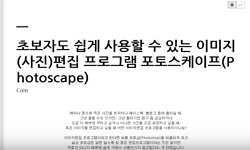웹3.0 환경에서 AI 기술은 사회 전반에 걸쳐 혁신 담론의 아이콘이 되었고 한국의 현대시도 AI 기술의 영향에서 벗어날 수 없게 되었다. 특히 최근 몇 년 사이 급격하게 발전한 대형언어모델(LL...
http://chineseinput.net/에서 pinyin(병음)방식으로 중국어를 변환할 수 있습니다.
변환된 중국어를 복사하여 사용하시면 됩니다.
- 中文 을 입력하시려면 zhongwen을 입력하시고 space를누르시면됩니다.
- 北京 을 입력하시려면 beijing을 입력하시고 space를 누르시면 됩니다.

웹3.0 환경과 AI를 활용한 시 쓰기 방안 연구 - 비유, 이미지, 리듬을 중심으로 - = Study on Poetry Writing in the Web 3.0 Era Using AI — Focusing on Metaphor, Imagery, and Rhythm
한글로보기부가정보
국문 초록 (Abstract)
첫째, 인간의 시 쓰기와 마찬가지로 Chat GPT 역시 프롬프팅에 의해 시 초안을 생성해 낼 수 있고, 은유와 환유, 상징과 알레고리 역시 구현할 수 있음을 확인할 수 있다. 그러나 이러한 일련의 과정은 모두 인간의 자율적인 결정에 따른 프롬프팅 혹은 대화와 학습의 결과물이므로, Chat GPT 스스로 창작했다고 말하기는 어렵다.
둘째, 시인은 특정한 이미지 파일을 생성형 AI에게 첨부하고 결괏값이 일정 수준에 도달할 때까지 학습 또는 대화를 전개하면 새로운 시를 창작해 낼 수 있다. 이때의 시-결과물을 얻기 위한 생성형 AI와의 시 쓰기 협업은 결국, 기존의 인간만의 ‘창작(creation)’이기보다는 마치 영화의 컷(cut)을 의도에 따라 몽타주로 구성하는 것처럼 AI의 생성물을 ‘편집(edit)’하는 행위로서의 과정이 될 것이다.
셋째, Suno와 같은 생성형 AI로 음악성이 강한 노래 가사에 가까운 시-초안을 생성해 낼 수 있고, ChatGPT에 사진-이미지를 첨부하거나 특정한 키워드 등을 입력한 후 원하는 수준의 비유와 시행 분절을 실현하도록 프롬프팅하여 새로운 시를 생성해 낼 수 있다.
시 쓰기 과정 중에 인간이 생성형 AI와 협업하는 일은, 기존의 인식 틀을 깨고 인간의 인식을 넘어서는 질문을 AI로부터 얻는 일이자 AI를 통해 인간의 사유 능력이라 할 수 있는 과거와 현재, 그리고 미래를 잇는 감각과 상상력을 ‘다시’ 질문하는 일이기도 하다. 이에 따라 AI는 인간의 감각과 상상력을 무한하게 확장하는 동시에 우리는 AI와의 소통을 통해 기존의 한계를 뛰어넘는 미적 경험 또한 가능해질 것이다.
웹3.0 환경에서 AI 기술은 사회 전반에 걸쳐 혁신 담론의 아이콘이 되었고 한국의 현대시도 AI 기술의 영향에서 벗어날 수 없게 되었다. 특히 최근 몇 년 사이 급격하게 발전한 대형언어모델(LLM) ChatGPT를 비롯한 ‘생성형 AI’는 그동안 인간만의 능력이라 믿었던 창의성의 영역까지 위협하고 있다. 이에 따라 본고는 시의 본질 혹은 시의 가장 중요한 요소라 할 수 있는 비유, 이미지, 리듬과 관련하여 생성형 AI 활용을 적극적으로 시도하여 다음과 같은 결론을 얻을 수 있었다.
첫째, 인간의 시 쓰기와 마찬가지로 Chat GPT 역시 프롬프팅에 의해 시 초안을 생성해 낼 수 있고, 은유와 환유, 상징과 알레고리 역시 구현할 수 있음을 확인할 수 있다. 그러나 이러한 일련의 과정은 모두 인간의 자율적인 결정에 따른 프롬프팅 혹은 대화와 학습의 결과물이므로, Chat GPT 스스로 창작했다고 말하기는 어렵다.
둘째, 시인은 특정한 이미지 파일을 생성형 AI에게 첨부하고 결괏값이 일정 수준에 도달할 때까지 학습 또는 대화를 전개하면 새로운 시를 창작해 낼 수 있다. 이때의 시-결과물을 얻기 위한 생성형 AI와의 시 쓰기 협업은 결국, 기존의 인간만의 ‘창작(creation)’이기보다는 마치 영화의 컷(cut)을 의도에 따라 몽타주로 구성하는 것처럼 AI의 생성물을 ‘편집(edit)’하는 행위로서의 과정이 될 것이다.
셋째, Suno와 같은 생성형 AI로 음악성이 강한 노래 가사에 가까운 시-초안을 생성해 낼 수 있고, ChatGPT에 사진-이미지를 첨부하거나 특정한 키워드 등을 입력한 후 원하는 수준의 비유와 시행 분절을 실현하도록 프롬프팅하여 새로운 시를 생성해 낼 수 있다.
시 쓰기 과정 중에 인간이 생성형 AI와 협업하는 일은, 기존의 인식 틀을 깨고 인간의 인식을 넘어서는 질문을 AI로부터 얻는 일이자 AI를 통해 인간의 사유 능력이라 할 수 있는 과거와 현재, 그리고 미래를 잇는 감각과 상상력을 ‘다시’ 질문하는 일이기도 하다. 이에 따라 AI는 인간의 감각과 상상력을 무한하게 확장하는 동시에 우리는 AI와의 소통을 통해 기존의 한계를 뛰어넘는 미적 경험 또한 가능해질 것이다.
다국어 초록 (Multilingual Abstract)
Second, poets can attach specific image files to generative AI and continue training or interacting with the AI until a satisfactory result is achieved, allowing for the creation of new poems. This collaboration between humans and generative AI in creating poetic results ultimately shifts the process from the traditional notion of human “creation” to an act of “editing” AI-generated outputs, akin to assembling film cuts into a montage.
Third, tools like Suno enable the generation of draft poems resembling lyrical song lyrics with strong musicality. By attaching photo-images or inputting specific keywords into ChatGPT, one can prompt the realization of desired levels of metaphor and line segmentation, resulting in the creation of new poetry.
Collaborating with generative AI in the process of writing poetry not only disrupts existing cognitive frameworks but also allows for questioning beyond human perception. It involves revisiting the senses and imagination that connect the past, present, and future—fundamental to human reasoning. This evolution will not only infinitely expand human sensory and imaginative capacities but also enable aesthetic experiences that transcend current limitations through communication with AI.
In the Web 3.0 era, AI technology has become a symbol of innovation discourse across various aspects of society, and modern Korean poetry has not remained unaffected by its influence. Particularly in recent years, generative AI, including large langua...
In the Web 3.0 era, AI technology has become a symbol of innovation discourse across various aspects of society, and modern Korean poetry has not remained unaffected by its influence. Particularly in recent years, generative AI, including large language models (LLMs) like ChatGPT, has rapidly advanced to the point of encroaching upon the domain of creativity, which was once believed to be uniquely human. In this context, this paper actively explores the use of generative AI in relation to metaphor, imagery, and rhythm—key elements of poetry—and arrives at the following conclusions: First, like human poets, ChatGPT can also generate draft poems based on prompts and implement metaphors, metonymy, symbols, and allegory. However, this process is entirely contingent upon human-initiated prompts and interactions, making it difficult to claim that ChatGPT independently creates poetry.
Second, poets can attach specific image files to generative AI and continue training or interacting with the AI until a satisfactory result is achieved, allowing for the creation of new poems. This collaboration between humans and generative AI in creating poetic results ultimately shifts the process from the traditional notion of human “creation” to an act of “editing” AI-generated outputs, akin to assembling film cuts into a montage.
Third, tools like Suno enable the generation of draft poems resembling lyrical song lyrics with strong musicality. By attaching photo-images or inputting specific keywords into ChatGPT, one can prompt the realization of desired levels of metaphor and line segmentation, resulting in the creation of new poetry.
Collaborating with generative AI in the process of writing poetry not only disrupts existing cognitive frameworks but also allows for questioning beyond human perception. It involves revisiting the senses and imagination that connect the past, present, and future—fundamental to human reasoning. This evolution will not only infinitely expand human sensory and imaginative capacities but also enable aesthetic experiences that transcend current limitations through communication with AI.
동일학술지(권/호) 다른 논문
-
지역 정주형 외국인 유학생 유치 정책의 현황 분석 및 시사점
- 한성어문학회
- 강소영
- 2025
- KCI등재
-
상호문화주의에 기반한 다문화 배경 학습자 대상 한국문화교육 연구
- 한성어문학회
- 안미홍
- 2025
- KCI등재
-
한국어 발음 진단 도구 설계를 위한 기초 연구 - 학습자 수용성을 중심으로 -
- 한성어문학회
- 심지혜
- 2025
- KCI등재
-
영상 문화저널리즘 층위 지상파 방송뉴스 한강 노벨문학상 보도의 성격
- 한성어문학회
- 김관섭
- 2025
- KCI등재




 KCI
KCI KISS
KISS






